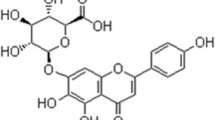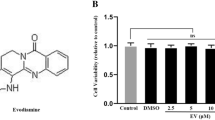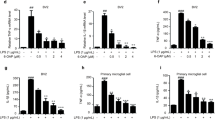Abstract
Ischemic stroke, caused by obstruction of blood flow to the brain, would initiate microglia activation which contributes to neuronal damage. Therefore, inhibition of microglia-mediated neuroinflammation could be a therapeutic strategy for ischemic stroke. This study was aimed to elucidate the anti-inflammatory effects of alpha-lipoic acid and etanercept given either singly or in combination in rats subjected to middle cerebral artery occlusion. Both α-lipoic acid and etanercept markedly reduced cerebral infarct, blood-brain barrier disruption, and neurological motor deficits with the former drug being more effective with the dosage used. Furthermore, when used in combination, the reduction was more substantial. Remarkably, a greater diminution in the serum levels of tumor necrosis factor-alpha as well as the brain levels of microglial activation (e.g., microgliosis, amoeboid microglia, and microglial overexpression of tumor necrosis factor-α) was observed with the combined drug treatment as compared to the drugs given separately. We conclude that inhibition of peripheral tumor necrosis factor-alpha as well as downregulation of brain microglial activation by alpha-lipoic acid or etanercept protect rat brain against ischemic stroke. Moreover, when both drugs were used in combination, the stroke recovery was promoted more extensively.








Similar content being viewed by others
References
Lambertsen KL, Biber K, Finsen B (2012) Inflammatory cytokines in experimental and human stroke. J Cereb Blood Flow Metab 32(9):1677–1698. doi:10.1038/jcbfm.2012.88
Brouns R, De Deyn PP (2009) The complexity of neurobiological processes in acute ischemic stroke. Clin Neurol Neurosurg 111(6):483–495. doi:10.1016/j.clineuro.2009.04.001
Tuttolomondo A, Di Raimondo D, Forte GI, Casuccio A, Vaccarino L, Scola L, Pecoraro R, Serio A et al (2012) Single nucleotide polymorphisms (SNPs) of pro-inflammatory/anti-inflammatory and thrombotic/fibrinolytic genes in patients with acute ischemic stroke in relation to TOAST subtype. Cytokine 58(3):398–405. doi:10.1016/j.cyto.2012.02.012
Tuttolomondo A, Di Raimondo D, Pecoraro R, Arnao V, Pinto A, Licata G (2012) Inflammation in ischemic stroke subtypes. Curr Pharm Des 18(28):4289–4310
Tuttolomondo A, Pecoraro R, Pinto A (2014) Studies of selective TNF inhibitors in the treatment of brain injury from stroke and trauma: a review of the evidence to date. Drug Des Devel Ther 8:2221–2238. doi:10.2147/DDDT.S67655. eCollection 2014
Jin R, Yang G, Li G (2010) Inflammatory mechanisms in ischemic stroke: role of inflammatory cells. J Leukoc Biol 87(5):779–789. doi:10.1189/jlb.1109766
Kettenmann H, Hanisch UK, Noda M, Verkhratsky A (2011) Physiology of microglia. Physiol Rev 91(2):461–553. doi:10.1152/physrev.00011.2010
Pinto A, Di Raimondo D, Tuttolomondo A, Fernandez P, Arnao V, Licata G (2006) Twenty-four hour ambulatory blood pressure monitoring to evaluate effects on blood pressure of physical activity in hypertensive patients. Clin J Sport Med 16(3):238–243
Tobinick E, Kim NM, Reyzin G, Rodriguez-Romanacce H, DePuy V (2012) Selective TNF inhibition for chronic stroke and traumatic brain injury: an observational study involving 629 consecutive patients treated with perispinal etanercept. CNS Drugs 26(12):1051–1070. doi:10.1007/s40263-012-0013-2
Tuttolomondo A, Di Raimondo D, Di Sciacca R, Casuccio A, Bivona G, Bellia C, Barreca L, Serio A et al (2010) Fetuin-A and CD40 L plasma levels in acute ischemic stroke: differences in relation to TOAST subtype and correlation with clinical and laboratory variables. Atherosclerosis 208(1):290–296. doi:10.1016/j.atherosclerosis.2009.07.032
Tuttolomondo A, Di Raimondo D, Pecoraro R, Serio A, D’Aguanno G, Pinto A, Licata G (2010) Immune-inflammatory markers and arterial stiffness indexes in subjects with acute ischemic stroke. Atherosclerosis 213(1):311–318. doi:10.1016/j.atherosclerosis.2010.08.065
Tuttolomondo A, Pecoraro R, Casuccio A, Di Raimondo D, Buttà C, Clemente G, Della Corte V, Guggino G et al (2015) Peripheral frequency of CD4+ CD28- cells in acute ischemic stroke: relationship with stroke subtype and severity markers. Medicine (Baltimore) 94(20), e813. doi:10.1097/MD.0000000000000813
Shichita T, Ago T, Kamouchi M, Kitazono T, Yoshimura A, Ooboshi H (2012) Novel therapeutic strategies targeting innate immune responses and early inflammation after stroke. J Neurochem 123(Suppl 2):29–38. doi:10.1111/j.1471-4159.2012.07941.x
Osburg B, Peiser C, Dömling D, Schomburg L, Ko YT, Voigt K, Bickel U (2002) Effect of endotoxin on expression of TNF receptors and transport of TNF-alpha at the blood-brain barrier of the rat. Am J Physiol Endocrinol Metab 283(5):E899–E908
Denes A, Thornton P, Rothwell NJ, Allan SM (2010) Inflammation and brain injury: acute cerebral ischaemia, peripheral and central inflammation. Brain Behav Immun 24(5):708–723. doi:10.1016/j.bbi.2009.09.010
Fu B, Zhang J, Zhang X, Zhang C, Li Y, Zhang Y, He T, Li P et al (2014) Alpha-lipoic acid upregulates SIRT1-dependent PGC-1α expression and protects mouse brain against focal ischemia. Neuroscience 281C:251–257. doi:10.1016/j.neuroscience.2014.09.058
Packer L, Tritschler HJ, Wessel K (1997) Neuroprotection by the metabolic antioxidant alpha-lipoic acid. Free Radic Biol Med 22(1–2):359–378
Panigrahi M, Sadguna Y, Shivakumar BR, Kolluri SV, Roy S, Packer L, Ravindranath V (1996) Alpha-lipoic acid protects against reperfusion injury following cerebral ischemia in rats. Brain Res 717(1–2):184–188
Wolz P, Krieglstein J (1996) Neuroprotective effects of alpha-lipoic acid and its enantiomers demonstrated in rodent models of focal cerebral ischemia. Neuropharmacology 35(3):369–375
Clark WM, Rinker LG, Lessov NS, Lowery SL, Cipolla MJ (2001) Efficacy of antioxidant therapies in transient focal ischemia in mice. Stroke 32(4):1000–1004
Cao X, Phillis JW (1995) The free radical scavenger, alpha-lipoic acid, protects against cerebral ischemia-reperfusion injury in gerbils. Free Radic Res 23(4):365–370
Connell BJ, Saleh M, Khan BV, Saleh TM (2011) Lipoic acid protects against reperfusion injury in the early stages of cerebral ischemia. Brain Res 1375:128–136. doi:10.1016/j.brainres.2010.12.045
Choi KH, Park MS, Kim HS, Kim KT, Kim HS, Kim JT, Kim BC, Kim MK et al (2015) Alpha-lipoic acid treatment is neurorestorative and promotes functional recovery after stroke in rats. Mol Brain 8:9. doi:10.1186/s13041-015-0101-6
Cinteza D, Berteanu M, Vladoiu S, Manolescu BN, Dinu H (2013) The consumption of Alanerv® nutritional supplement and the dynamic of some inflammatory markers in post-acute stroke patients undergoing rehabilitation. Maedica (Buchar) 8(2):137–142
Francis J, Chu Y, Johnson AK, Weiss RM, Felder RB (2004) Acute myocardial infarction induces hypothalamic cytokine synthesis. Am J Physiol Heart Circ Physiol 286(6):H2264–H2271
Tobinick E, Rodriguez-Romanacce H, Levine A, Ignatowski TA, Spengler RN (2014) Immediate neurological recovery following perispinal etanercept years after brain injury. Clin Drug Investig 34(5):361–366. doi:10.1007/s40261-014-0186-1
Chio CC, Chang CH, Wang CC, Cheong CU, Chao CM, Cheng BC, Yang CZ, Chang CP (2013) Etanercept attenuates traumatic brain injury in rats by reducing early microglial expression of tumor necrosis factor-α. BMC Neurosci 14:33. doi:10.1186/1471-2202-14-33
Lee S, Lee M, Hong Y, Won J, Lee Y, Kang SG, Chang KT, Hong Y (2014) Middle cerebral artery occlusion methods in rat versus mouse models of transient focal cerebral ischemic stroke. Neural Regen Res 9:757–758
Durukan A, Tatlisumak T (2007) Acute ischemic stroke: overview of major experimental rodent models, pathophysiology, and therapy of focal cerebral ischemia. Pharmacol Biochem Behav 87(1):179–197
Bederson JB, Pitts LH, Germano SM, Nishimura MC, Davis RL, Bartkowski HM (1986) Evaluation of 2,3,5-triphenyltetrazolium chloride as a stain for detection and quantification of experimental cerebral infarction in rats. Stroke 17(6):1304–1308
Longa EZ, Weinstein PR, Carlson S, Cummins R (1989) Reversible middle cerebral artery occlusion without craniectomy in rats. Stroke 20(1):84–91
Chen SF, Hsu CW, Huang WH, Wang JY (2008) Post-injury baicalein improves histological and functional outcomes and reduces inflammatory cytokines after experimental traumatic brain injury. Br J Pharmacol 155(8):1279–1296. doi:10.1038/bjp.2008.345
Chang MW, Young MS, Lin MT (2008) An inclined plane system with microcontroller to determine limb motor function of laboratory animals. J Neurosci Methods 168(1):186–194
Gartshore G, Patterson J, Macrae IM (1997) Influence of ischemia and reperfusion on the course of brain tissue swelling and blood-brain barrier permeability in a rodent model of transient focal cerebral ischemia. Exp Neurol 147(2):353–360
Lin TN, He YY, Wu G, Khan M, Hsu CY (1993) Effect of brain edema on infarct volume in a focal cerebral ischemia model in rats. Stroke 24(1):117–121
Jiang Y, Deacon R, Anthony DC, Campbell SJ (2008) Inhibition of peripheral TNF can block the malaise associated with CNS inflammatory diseases. Neurobiol Dis 32(1):125–132
Hansel G, Tonon AC, Guella FL, Pettenuzzo LF, Duarte T, Duarte MM, Oses JP, Achaval M et al (2014) Guanosine protects against cortical focal ischemia. Involvement of Inflammatory Response Mol Neurobiol DOI. doi:10.1007/s 12035-014-8978-0
Gelosa P, Lecca D, Fumagalli M, Wypych D, Pignieri A, Cimino M, Verderio C, Enerbäck M et al (2014) Microglia is a key player in the reduction of stroke damage promoted by the new antithrombotic agent ticagrelor. J Cereb Blood Flow Metab 34(6):979–988. doi:10.1038/jcbfm.2014.45
Kuang X, Wang LF, Yu L, Li YJ, Wang YN, He Q, Chen C, Du JR (2014) Ligustilide ameliorates neuroinflammation and brain injury in focal cerebral ischemia/reperfusion rats: involvement of inhibition of TLR4/peroxiredoxin 6 signaling. Free Radic Biol Med 71:165–175. doi:10.1016/j.freeradbiomed.2014.03.028
Zhou R, Yang Z, Tang X, Tan Y, Wu X, Liu F (2013) Propofol protects against focal cerebral ischemia via inhibition of microglia-mediated proinflammatory cytokines in a rat model of experimental stroke. PLoS One 8, e82729. doi:10.1371/journal.pone.0082729
Yuan Y, Zha H, Rangarajan P, Ling EA, Wu C (2014) Anti-inflammatory effects of edaravone and scutellarin in activated microglia in experimentally induced ischemia injury in rats and in BV-2 microglia. BMC Neurosci 15:125. doi:10.1186/s12868-014-0125-3
Chio CC, Lin JW, Chang MW, Wang CC, Kuo JR, Yang CZ, Chang CP (2010) Therapeutic evaluation of etanercept in a model of traumatic brain injury. J Neurochem 115:921–929
Pires PW, Girgla SS, Moreno G, McClain JL, Dorrance AM (2014) Tumor necrosis factor-α inhibition attenuates middle cerebral artery remodeling but increases cerebral ischemic damage in hypertensive rats. Am J Physiol Heart Circ Physiol 307(5):H658–69. doi:10.1152/ajpheart.00018.2014
McCoy MK, Tansey MG (2008) TNF signaling inhibition in the CNS: implications for normal brain function and neurodegenerative disease. J Neuroinflammation 5:45
Knoblach SM, Fan L, Faden AI (1999) Early neuronal expression of tumor necrosis factor-alpha after experimental brain injury contributes to neurological impairment. J Neuroimmunol 95:115–125
Chio CC, Lin MT, Chang CP (2015) Microglial activation as a compelling target for treating acute traumatic brain injury. Curr Med Chem 22:759–770
Licata G, Tuttolomondo A, Corrao S, Di Raimondo D, Fernandez P, Caruso C, Avellone G, Pinto A (2006) Immunoinflammatory activation during the acute phase of lacunar and non-lacunar ischemic stroke: association with time of onset and diabetic state. Int J Immunopathol Pharmacol 19(3):639–646
Pinto A, Tuttolomondo A, Casuccio A, Di Raimondo D, Di Sciacca R, Arnao V, Licata G (2009) Immuno-inflammatory predictors of stroke at follow-up in patients with chronic non-valvular atrial fibrillation (NVAF). Clin Sci (Lond) 116(10):781–789. doi:10.1042/CS20080372
Davì G, Tuttolomondo A, Santilli F, Basili S, Ferrante E, Di Raimondo D, Pinto A, Licata G (2009) CD40 ligand and MCP-1 as predictors of cardiovascular events in diabetic patients with stroke. J Atheroscler Thromb 16(6):707–713
Albanese A, Tuttolomondo A, Anile C, Sabatino G, Pompucci A, Pinto A, Licata G, Mangiola A (2005) Spontaneous chronic subdural hematomas in young adults with a deficiency in coagulation factor XIII. Report of three cases. J Neurosurg 102(6):1130–1132
Adams HP Jr, Bendixen BH, Kappelle LJ, Biller J, Love BB, Gordon DL, Marsh EE 3rd (1993) Classification of subtype of acute ischemic stroke. Definitions for use in a multicenter clinical trial. TOAST. Trial of Org 10172 in Acute Stroke Treatment. Stroke 24(1):35–41
Tuttolomondo A, Di Raimondo D, Di Sciacca R, Pecoraro R, Arnao V, Buttà C, Licata G, Pinto A (2012) Arterial stiffness and ischemic stroke in subjects with and without metabolic syndrome. Atherosclerosis 225(1):216–219. doi:10.1016/j.atherosclerosis.2012.08.027
Pinto A, Di Raimondo D, Tuttolomondo A, Buttà C, Milio G, Licata G (2012) Effects of physical exercise on inflammatory markers of atherosclerosis. Curr Pharm Des 18(28):4326–4349. doi:10.1016/j.atherosclerosis.2012.08.027
Bramanti V, Tomassoni D, Bronzi D, Grasso S, Currò M, Avitabile M, Li Volsi G, Renis M et al (2010) Alpha-lipoic acid modulates GFAP, vimentin, nestin, cyclin D1 and MAP-kinase expression in astroglial cell cultures. Neurochem Res 35:2070–2077. doi:10.1007/s11064-010-0256-6
Acknowledgments
This study is supported in part by research grant Chi Mei Medical Center and NSC 101-2314-B-218-001-MY3 from the Taiwan National Science and Technology Department and Taiwan Ministry of Health and Welfare Clinical Trial and Research Center of Excellence (MOHW104-TDU-B-212-113002); China Medical University Hospital; Academia Sinica Taiwan Biobank; Stroke Biosignature Project (BM104010092); NRPB Stroke Clinical Trial Consortium (MOST 103-2325-B-039-006-); Tseng-Lien Lin Foundation, Taichung, Taiwan; Taiwan Brain Disease Foundation, Taipei, Taiwan; and Katsuzo and Kiyo Aoshima Memorial Funds, Japan.
Conflict of Interest
The authors declare that they have no competing interests.
Author information
Authors and Affiliations
Corresponding author
Rights and permissions
About this article
Cite this article
Wu, MH., Huang, CC., Chio, CC. et al. Inhibition of Peripheral TNF-α and Downregulation of Microglial Activation by Alpha-Lipoic Acid and Etanercept Protect Rat Brain Against Ischemic Stroke. Mol Neurobiol 53, 4961–4971 (2016). https://doi.org/10.1007/s12035-015-9418-5
Received:
Accepted:
Published:
Issue Date:
DOI: https://doi.org/10.1007/s12035-015-9418-5




